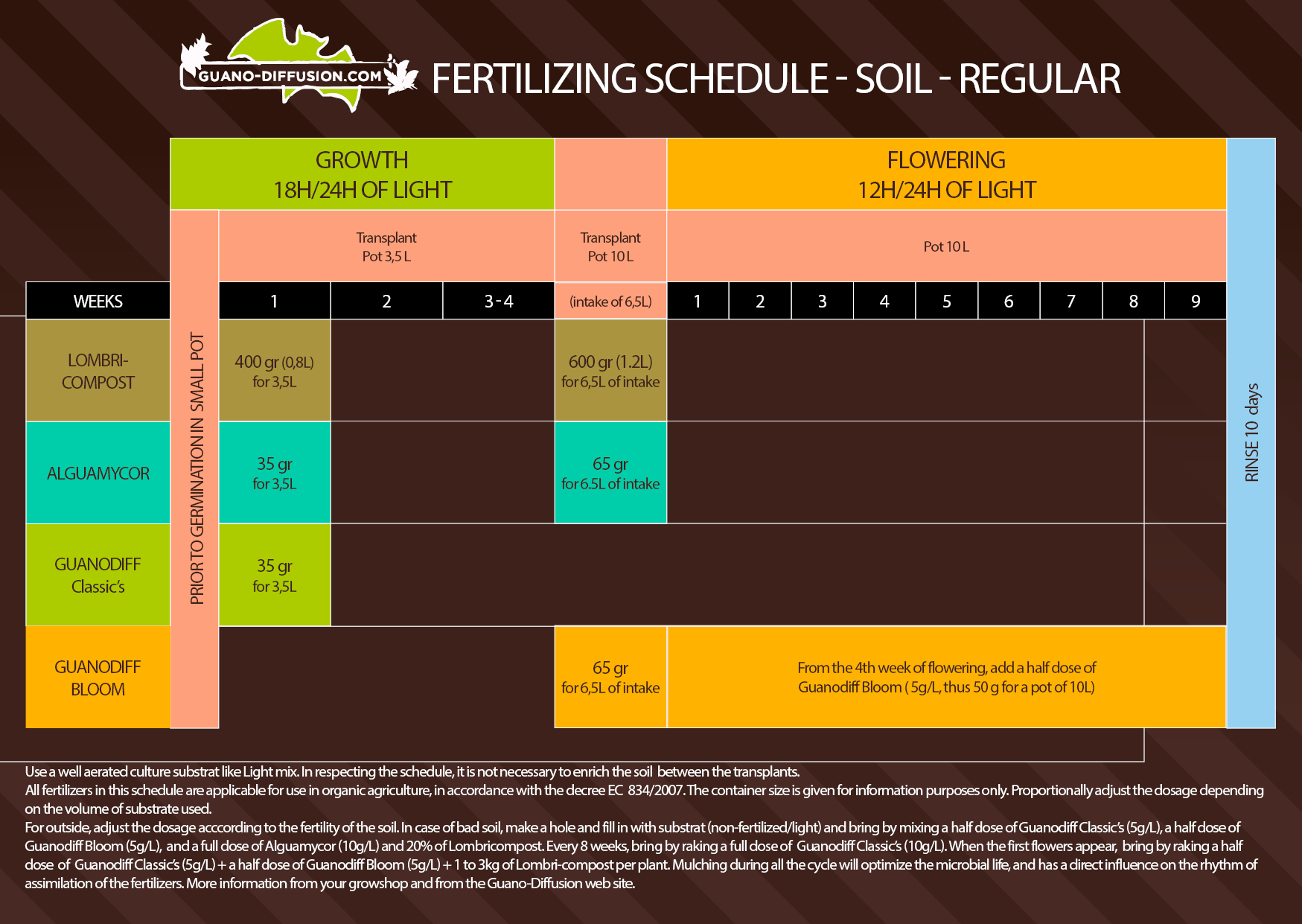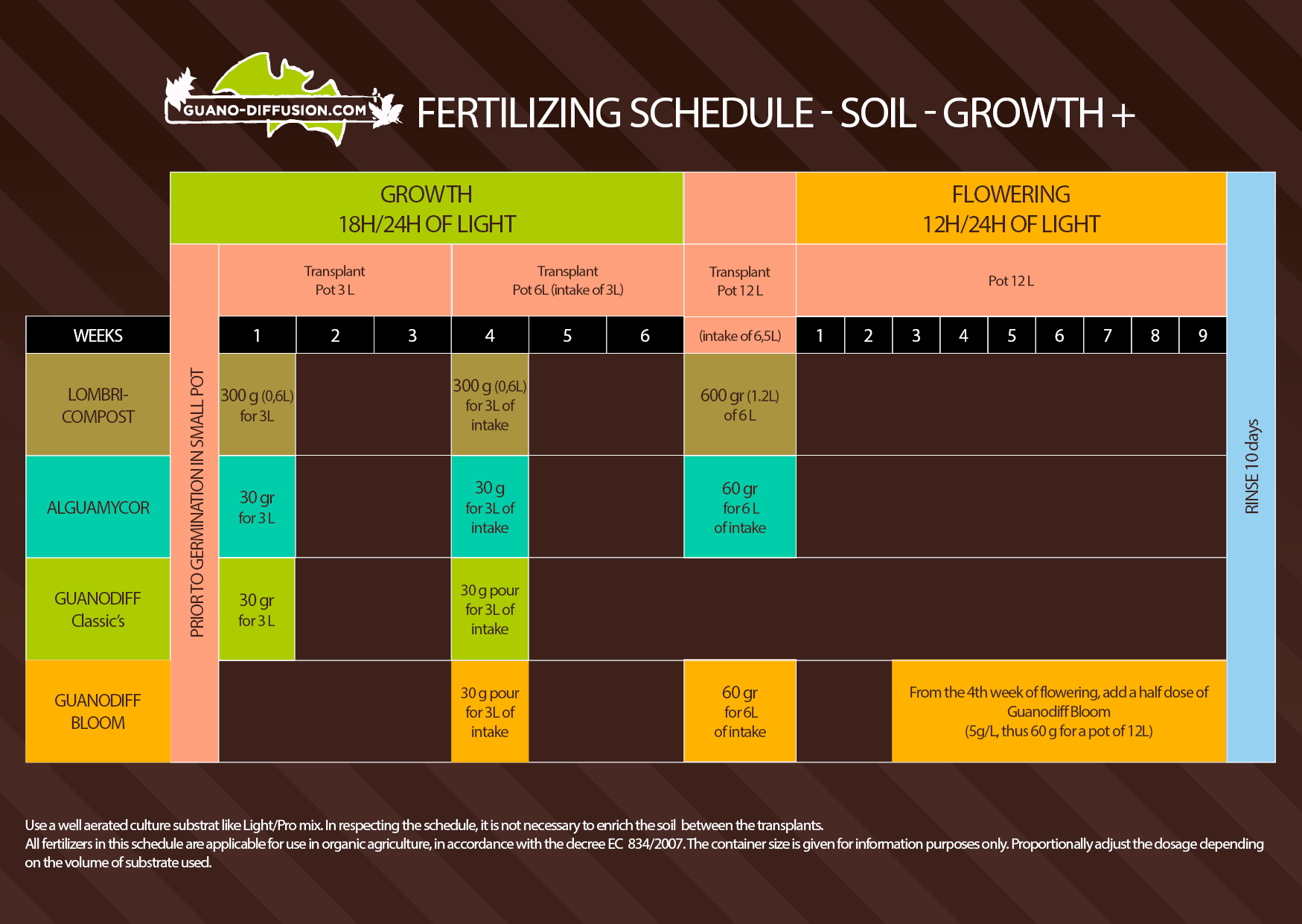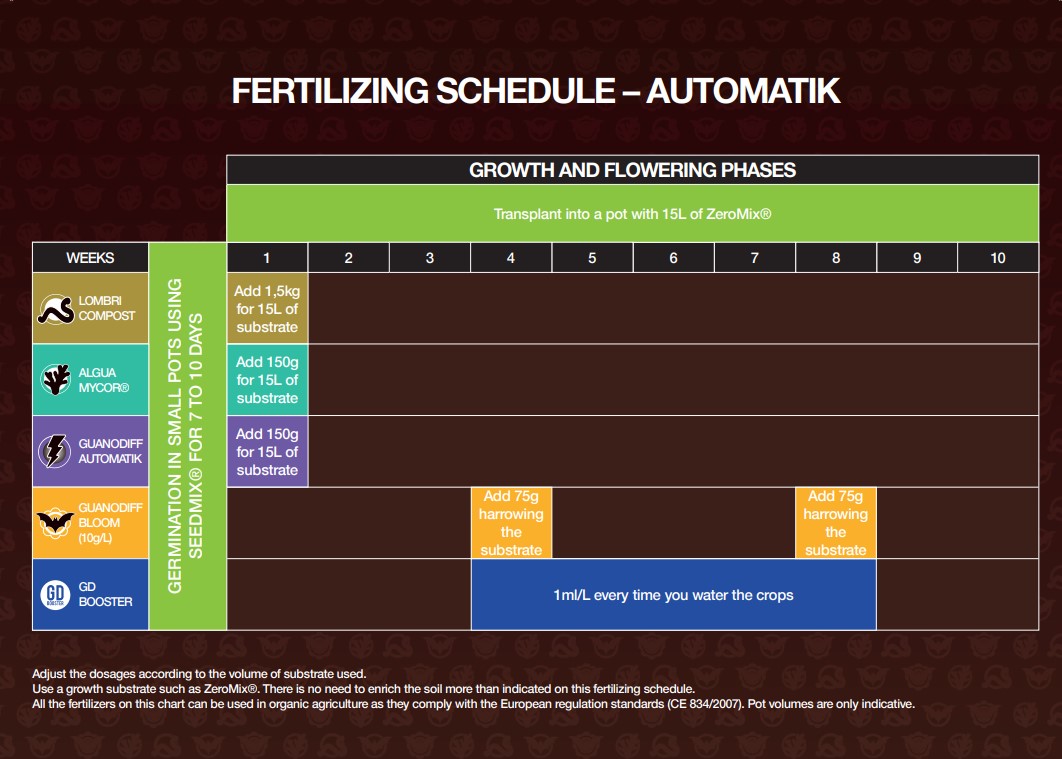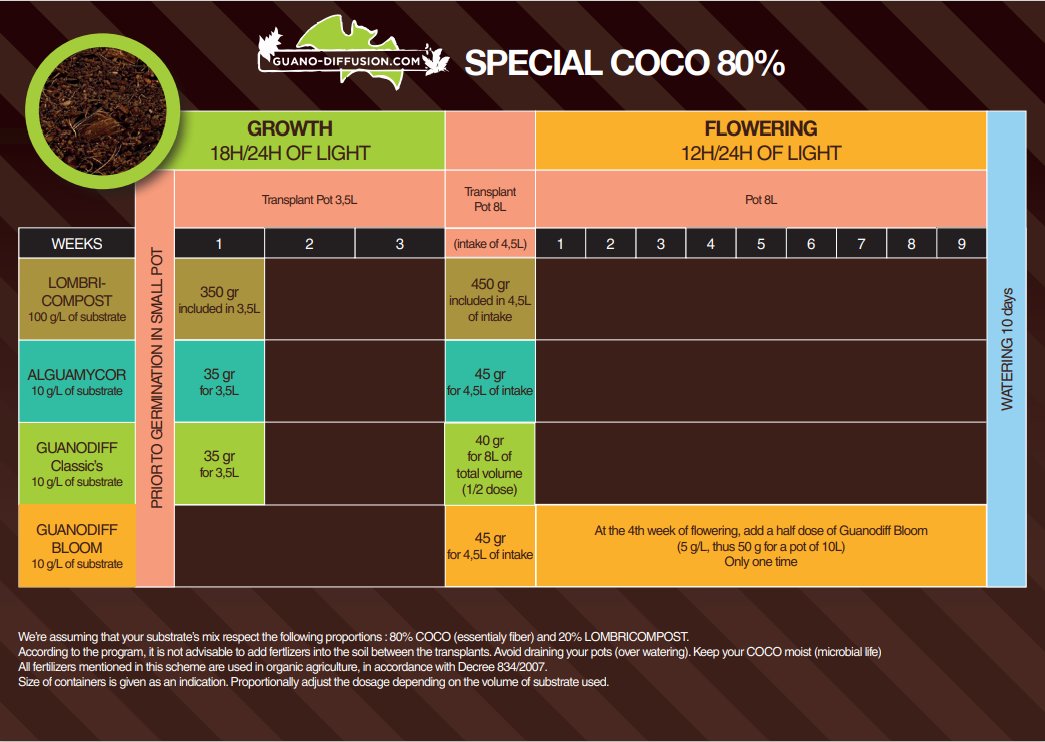| Type of plant | Classic NPK : 3-8-0,7 ( g/m2) | Bloom NPK : 3-6-10 ( g/m2) | Alguamycor NPK : 2-0- 3,5 ( g/m2) | Lombricompost NPK : 1-0,8-0,6 (g/m2) | Yearly intakes | ||
|---|---|---|---|---|---|---|---|
| Artichokes | Add lombricompost before planting your seeds. Then add fertilizers every 3 weeks. | ||||||
| Horticultural crops | |||||||
| Tomatoes (100T/ha) | 200 | 270 | 200 | 400 | Add lombricompost during the fall season preceding planting your seeds. Then, add Classic’s and Alguamycor when transplanting your crops. Use Bloom for the flowering phase. | ||
| Leeks (65T/ha) | 250 | 80 | 0 | 400 | Add lombricompost and fertilizers when planting your seeds and to sustain their growth (49g per leek) | ||
| Eggplants (grown in a greenhouse)(100T/ha) | 100 | 165 | 100 | 400 | Add lombricompost and fertilizers when planting your seeds and to sustain their growth. | ||
| Eggplants (field grown) (65T/ha) | 100 | 165 | 100 | 400 | Add lombricompost and fertilizers when planting your seeds and to sustain their growth. | ||
| Cucumbers (175T/ha) | 160 | 200 | 160 | 1000 | Add lombricompost and fertilizers when planting your seeds and to sustain their growth. | ||
| Zucchinis (30T/ha) | 100 | 165 | 100 | 400 | Add lombricompost and fertilizers when planting your seeds and to sustain their growth. | ||
| Lettuce (14 heads of lettuce/m2) | 65 | 0 | 0 | 400 | Add lombricompost and fertilizers when planting your seeds and to sustain their growth. | ||
| Melons (35T/ha) | 60 | 100 | 60 | 400 | Add lombricompost and fertilizers when planting your seeds and to sustain their growth. | ||
| Peppers (grown in a greenhouse) (70T/ha) | 100 | 165 | 100 | 400 | Add lombricompost and fertilizers when planting your seeds and to sustain their growth. | ||
| Peppers (field-grown) (100T/ha) | 175 | 210 | 175 | 400 | Add lombricompost and fertilizers when planting your seeds and to sustain their growth. | ||
| Potatoes (40T/ha) | 160 | 40 | 0 | 800 | Add lombricompost and fertilizers when planting your seeds and to sustain their growth. | ||
| Cabbages (70T/ha) | 160 | 40 | 0 | 800 | Add lombricompost and fertilizers when planting your seeds and to sustain their growth. | ||
| Asparagus (6T/ha) | 200 | 30 | 0 | 400 | Add lombricompost and fertilizers when planting your seeds and to sustain their growth. | ||
| Carrots (60T/ha) | 200 | 30 | 0 | 400 | Add 1,5 to 2 monthes before planting your seeds. | ||
| Radishes (16T/ha) | 0 | 0 | 0 | 0 | |||
| Peas | 0 | 0 | 0 | 0 | |||
| Garlic (7T/ha) | 120 | 40 | 0 | 400 | Add lombricompost and fertilizers when planting your seeds and to sustain their growth. | ||
| Onions(12T/ha) | 120 | 40 | 0 | 400 | Add lombricompost and fertilizers when planting your seeds and to sustain their growth. | ||
| Vines (100hl/ha) | 0 | 85 | 20 | 0 | Add lombricompost and fertilizers when planting your seeds, to sustain their growth and after harvesting. | ||
| Artichokes | 20 | 35 | 20 | 400 | Add lombricompost and fertilizers when planting your seeds and then every 3 weeks to sustain their growth. | ||
| Chicory | 150 | 50 | 0 | 400 | Add lombricompost and fertilizers when planting your seeds and to sustain their growth. | ||
| Spinach | 120 | 130 | 120 | 400 | Add lombricompost and fertilizers when planting your seeds. Then, add around 1600kg/ha before the growth phase with 4 leaves. | ||
| Green bean | 70 | 80 | 70 | 400 | Add lombricompost and fertilizers when planting your seeds and to sustain their growth. | ||
| Beetroots | 250 | 80 | 0 | 800 | Add lombricompost and fertilizers when planting your seeds and to sustain their growth. | ||
| For your entire vegetable garden if it has a poor soil | 200 | 167 | 0 | 400 | Add lombricompost during the fall season. Add Classic’s and Bloom when planting your seeds and to sustain the vegetables’ growth. | ||
| RED BERRIES | |||||||
| Blackcurrants | 12 | 12 | 12 | 100 | Add lombricompost and fertilizers in winter and in spring (lightly harrow the substrate before adding fertilizers) | ||
| Redcurrants | 12 | 12 | 12 | 100 | Add lombricompost and fertilizers in winter and in spring (lightly harrow the substrate before adding fertilizers) | ||
| Strawberries (55T/ha) | 185 | 185 | 185 | 400 | Add lombricompost and fertilizers in winter and in spring (lightly harrow the substrate before adding fertilizers) | ||
| Raspberries | 125 | 125 | 125 | 400 | Add lombricompost and fertilizers in winter and in spring (lightly harrow the substrate before adding fertilizers) | ||
| ORCHARDS | |||||||
| Apple trees | 0 | 60 | 20 | 100 | Add lombricompost and fertilizers in winter and in spring (lightly harrow the substrate before adding fertilizers) | ||
| Pear trees, cherry trees, mirabelle plum trees, walnut trees, damson plum trees | 0 | 60 | 20 | 400 | Add lombricompost and fertilizers in winter and in spring (lightly harrow the substrate before adding fertilizers) | ||
| NURSERIES AND FLOWERS | |||||||
| Ornamental nursery, fruit-tree nurseries and forest nurseries | 45 | 45 | 15 | 400 | Add Alguamycor only when transplanting. | ||
| Flower crops | 200 | 200 | 200 | 800 | Harrow the soil at the foot of the crops before adding fertilizers. | ||
| TURF | |||||||
| TURF | 300 | 0 | 150 | 100 | Add when planting and to sustain growth | ||
| FIELD CROPS | Classic (en kg/ha) | Bloom (en kg/ha) | Alguamycor (en kg/ha) | Lombricompost (en kg/ha) | |||
| CULTIVOS LARGOS | |||||||
| Cereals with long stems (70q/ha) | 5000 | 0 | 0 | 0 | Add 1667kg/ha at tillering, 1667kg/ha when the ears reach 1cm and 1667kg/ha when they start swelling. | ||
| Corn (100q/ha) | 4333 | 0 | 0 | 0 | Add 1667kg/ha when planting, 1667kg/ha when the plants reach having 5 to 6 leaves, and 999kg/ha when they reach having 10/12 leaves | ||
| Silage Corn | 4533 | 0 | 0 | 0 | Add 1333kg/ha when planting, and the rest when the plants have 6/8 leaves. | ||
| Rapeseed (40q/ha) | 6667 | 0 | 0 | 0 | Add 1333kg/ha when planting, 3333kg/ha when plants reach the stage of having joined buds, and 2000kg/ha when the buds separate. | ||
| Sunflowers (25q/ha) | 1767 | 0 | 0 | 0 | Add when planting or before planting. | ||
| PASTURES WITH A LOAD OF 25 TO 40 AREAS/livestock unit | |||||||
| Grazed meadows | 2667 | 0 | 0 | 0 | Add when livestock leave the pasture | ||
| Grazed and mowed meadows | 3667 | 0 | 0 | 0 | Add when livestock leave the pasture | ||
| Mowed meadows | 3333 | 0 | 0 | 0 | Add 2000kg/ha at the beginning of spring and 1333kg/ha at the end of spring. | ||
| This feed chart has been established for an average soil. For more precise dosages and advice, analyzing your soil composition would be necessary. Moreover, in the case of field crops, one would also have to take the remainders of previous crops after harvest into account. |
Feeding charts for indoor crops transplanted 2 or 3 times during one life cycle of more or less 3-month long.



I.Configuration EXT n°1 : outdoor crops in open ground with a relatively naturally fertile soil
When crops reach 10cm, plant outdoor in the open ground adding 80g of bat guano Guanodiff Classic’s + 80g of Alguamycor + 1kg of Lombricompost. Mulch in order to preserve surface microbial activity and to limit evaporation. Right from the beginning of the flowering phase (in general in mid-august) harrow the soil and add 80g of GUANODIFF BLOOM. Water, keep the soil mulched for moisture conservation and in order to preserve microbial activity.
II. Configuration EXT n°2 : outdoor crops in a hole in the ground filled with fertilized substrate
Choose this configuration when your soil is not rich enough and completely control the level
of fertilization of your substrate.
Note that in that configuration, there won’t be any transplant.
II.1 In spring, when your plant reaches 10cm of height, transplant it outdoor in a mix of neutral substrate (horticultural substrate without any fertilizer) with the following fertilizers :
100g/L of lombricompost (1kg of Lombricompost per 100L of substrate) – 10g /L of Alguamycor® - 5g/L of Guanodiff Classic’s (50g/100L of substrate) – 5g/L de Guanodiff Bloom (50g/100L of substrate) – Water with clean water, keep the soil mulched for moisture conservation and in order to preserve microbial activity.
II.2 After 8 weeks (in general around mid-june), score the soil and add :
10g/L of Guanodiff Classic’s (100g/10L) – Remove the mulch before abundantly watering, and then mulch again.
II.3 After 8 weeks (in general around mid-august), add :
• 5g/L of Guanodiff Bloom (50g/10L) • 5g/L of Guanodiff Classic’s (optional dose according to the type of plant you’re growing) We strongly recommend adding Lombricompost (around 1kg to 3kg per plant, depending on their size) with which you’ll mix the fertilizers. Then, add this rich mixture to the soil after harrowing it. By harrowing the soil, you’ll add the mix to the first five centimeters of it. Water and mulch again.
III. Configuration EXT n°3: outdoor potted crops
Choose this configuration when you want to grow your crops in plants and let them benefit from the best source of light ever (the Sun !) at the same time !
Click here to use our nutrient calculator for outdoor potted crops.III.1 In spring, when your plants reach 8 to 10cm of height , transplant it in a growing pot with a mix of neutral substrate (horticultural substrate without any fertilizer - EC 1.1mS/cm3) and :
• 100g/L of Lombricompost (1Kg of Lombricompost per each 10L of light substrate) • 10g/L of Alguamycor (100g of Alguamycor per each 10L of substrate) • 10g/L og Guanodiff Classic’s Water with clear water and then mulch your soil mulched for moisture conservation and in order to preserve microbial activity.
III.2 When time comes to transplant your corps in an in-between pot, repeat III.1 with the same dosages of Alguamycor, Guanodiff Classic’s and Lombricompost, taking the volume of added substrate as your basis of calculation.
Remove the mulch, and mix with the added substrate : • 100g/L of Lombricompost (1Kg of Lombricompost per each 10L of light substrate) • 10g/L of Alguamycor (100g of Alguamycor for each 10L of substrate) • 10g/L og Guanodiff Classic’s Example : if you transplant a crop from a 3,5L pot into a 10L pot, you’ll need to fertilize the volume of added susbstrate, which is 6,5L in this case. Therfore, for each 10L pot, you’ll have to mix 6,5L of substrate with 650g of Lombricompost, 65g of Alguamycor and 65g of Guanodiff Classic’s.
III.3 When time comes to transplant your crops in their final pot, your basis of calculation for the quantities of fertilizers to add will still be the added volumen of substrate. You will then add :
• 100g/L of Lombricompost (1Kg of Lombricompost for each 10L of light substrate) • 10g/L of Alguamycor (100g of Alguamycor for each 10L of substrate) • 10g/L of Guanodiff Classic’s Note : the substrate used in this case absolutely has to be neutral and light (EC 1.1 cm3)
III.4 Between 6 and 8 weeks after transplanting your crop in its final pot (generally in mid- august), add some more fertilizers to the first 5 cm of the soil by harrowing it and in the following quantities :
• 5g/L of Guanodiff Bloom (250g for every 50L of substrate) • 5g/L of Guanodiff Classic’s (250g for every 50L of substrate) : optional dose depending on the type of crops you’re growing • 10g/L of Guanodiff Classic’s We strongly recommend adding Lombricompost (around 1kg to 3kg per plant, depending on their size) with which you’ll mix the fertilizers. Then, add this rich mixture to the soil after harrowing it. By harrowing the soil, you’ll add the mix to the first five centimeters of it. Water and mulch again.
At Guano Diffusion, all our fertilizers have been developed and tested for optimal effects when directly mixed with the substrate. Growing fertilizers should be mixed with the substrate when transplanting crops in their growing pot, whereas flowering fertilizers should be mixed with the substrate when transplanting your crops in their final pot.
For crops cultivated in pots, the quantity of fertilizers to add when transplanting your crops from one pot to a bigger pot depend on the volume of added substrate. For example, if you transplant a crop from a 3,5L growing pot into a 10L flowering pot, you’ll need to fertilize the volume of added susbstrate, which is 6,5L in this case. Therfore, for each 10L pot, you’ll have to mix 6,5L of substrate with 65g of Guanodiff Bloom. But in the case of plants grown using AUTOPOT systems, there won’t be any transplants. So you won’t be adding substrate at different stages of your plants’ development. In such a a case, here is how to use our fertilizers :
- 1.Plant your seeds in a +/- 1,5L pot, using GD SeedMix. Wait until your plant reaches a height of 15cm before transplanting it in your Autopot system.
- 2.Prepare your substrate : 50% of ZEROMIX® + 30% perlite + 20% Lombricompost Guano- Diffusion
- 3.Mix your substrate with :
o 10 g/L of Alguamycor
o 5 g/L of Guanodiff Classic’s
o 5 g/l of Guanodiff Bloom - During the first seven dayx, wáter your Autopot from above in order to optimize the development of your plant’s root system. Then, turn on your Autopot system.
- At the end of the growing pase, prepare a dose of 5g/L of Guanodiff Bloom (which corresponds for example to 75g of Guanodiff Bloom if your pot contains 15L of substrate). Add that quantity of Guanodiff Bloom to your substrate after harrowing it. Repeat every 4 weeks with half-a-dose of Guanodiff Bloom. The last dose should not be given to your plants less than 4 weeks before harvest.

